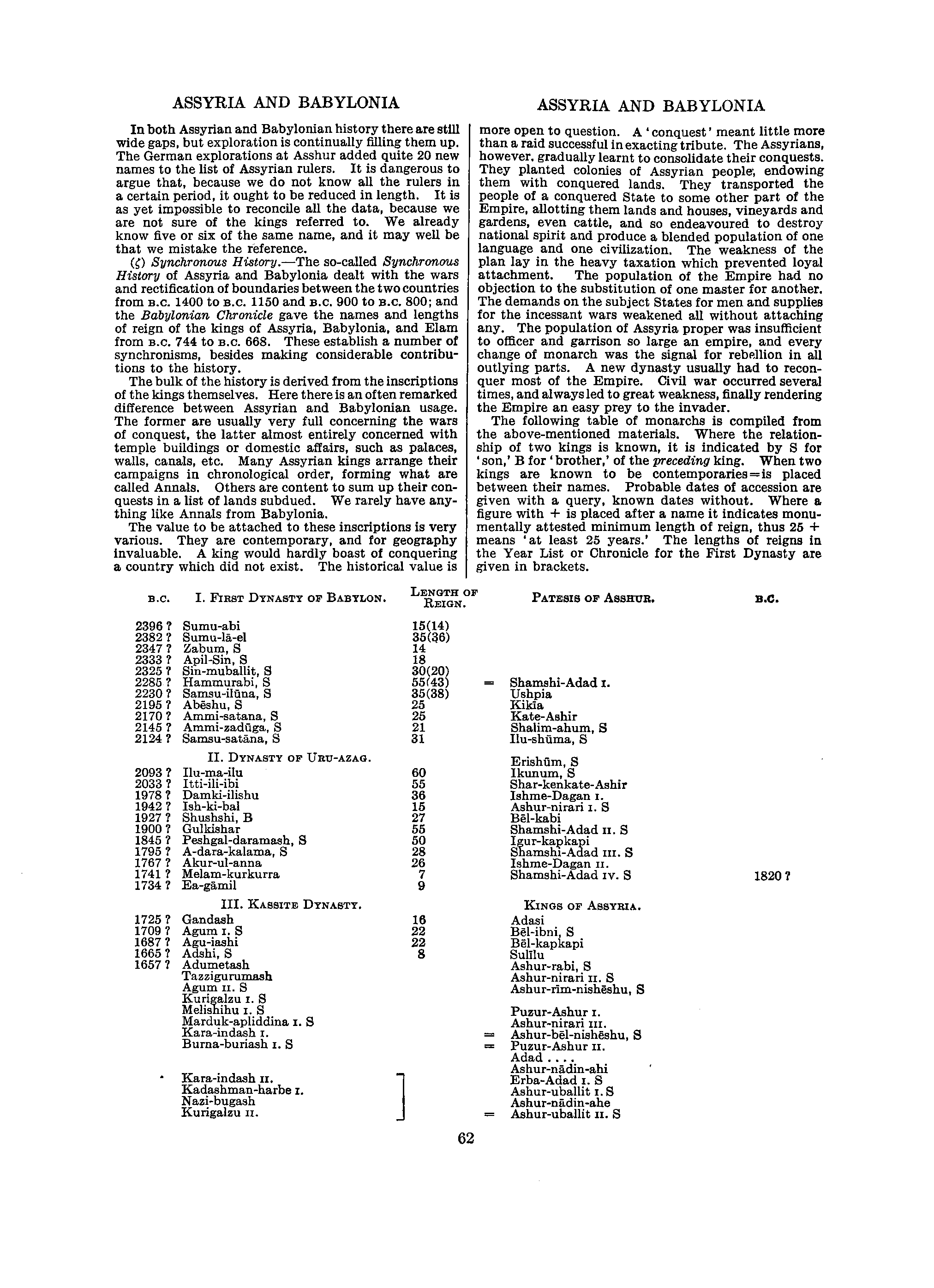ASSYRIA
AND
BABYLONIA
In
both
Assyrian
and
Babylonian
history
there
are
still
wide
gaps,
but
exploration
is
continually
filling
them
up.
The
German
explorations
at
Asshur
added
quite
20
new
names
to
the
list
of
Assyrian
rulers.
It
is
dangerous
to
argue
that,
because
we
do
not
know
all
the
rulers
in
a
certain
period,
it
ought
to
be
reduced
in
length.
It
is
as
yet
impossible
to
reconcile
all
the
data,
because
we
are
not
sure
of
the
Icings
referred
to.
We
already
know
five
or
six
of
the
same
name,
and
it
may
well
be
that
we
mistake
the
reference.
(i)
Synchronous
History.
—
The
so-called
Synchronous
History
of
Assyria
and
Babylonia
dealt
with
the
wars
and
rectification
of
boundaries
between
the
two
countries
from
B.C.
1400
to
B.C.
1150
and
B.C.
900
to
B.C.
800;
and
the
Babylonian
Chronicle
gave
the
names
and
lengths
of
reign
of
the
kings
of
Assyria,
Babylonia,
and
Elam
from
B.C.
744
to
B.C.
668.
These
establish
a
number
of
synchronisms,
besides
making
considerable
contribu-tions
to
the
history.
The
bulk
of
the
history
is
derived
from
the
inscriptions
of
the
kings
themselves.
Here
there
is
an
often
remarked
difference
between
Assyrian
and
Babylonian
usage.
The
former
are
usually
very
full
concerning
the
wars
of
conquest,
the
latter
almost
entirely
concerned
with
temple
buildings
or
domestic
affairs,
such
as
palaces,
walls,
canals,
etc.
Many
Assyrian
kings
arrange
their
campaigns
in
chronological
order,
forming
what
are
called
Annals.
Others
are
content
to
sum
up
their
con-quests
in
a
list
of
lands
subdued.
We
rarely
have
any-thing
like
Annals
from
Babylonia.
The
value
to
be
attached
to
these
inscriptions
is
very
various.
They
are
contemporary,
and
for
geography
Invaluable.
A
king
would
hardly
boast
of
conquering
a
country
which
did
not
exist.
The
historical
value
is
ASSYRIA
AND
BABYLONIA
more
open
to
question.
A
'
conquest
'
meant
little
more
than
a
raid
successful
in
exacting
tribute.
The
Assyrians,
however,
gradually
learnt
to
consolidate
their
conquests.
They
planted
colonies
of
Assyrian
people;
endowing
them
with
conquered
lands.
They
transported
the
people
of
a
conquered
State
to
some
other
part
of
the
Empire,
allotting
them
lands
and
houses,
vineyards
and
gardens,
even
cattle,
and
so
endeavoured
to
destroy
national
spirit
and
produce
a
blended
population
of
one
language
and
one
civilization.
The
weakness
of
the
plan
lay
in
the
heavy
taxation
which
prevented
loyal
attachment.
The
population
of
the
Empire
had
no
objection
to
the
substitution
of
one
master
for
another.
The
demands
on
the
subject
States
for
men
and
supplies
for
the
incessant
wars
weakened
all
without
attaching
any.
The
population
of
Assyria
proper
was
insufficient
to
officer
and
garrison
so
large
an
empire,
and
every
change
of
monarch
was
the
signal
for
rebellion
in
all
outlying
parts.
A
new
dynasty
usually
had
to
recon-quer
most
of
the
Empire.
Civil
war
occurred
several
times,
and
always
led
to
great
weakness,
finally
rendering
the
Empire
an
easy
prey
to
the
invader.
The
following
table
of
monarchs
is
compiled
from
the
above-mentioned
materials.
Where
the
relation-ship
of
two
kings
is
known,
it
is
indicated
by
S
for
'
son,'
B
for
'
brother,'
of
the
preceding
king.
When
two
kings
are
known
to
be
contemporaries
=
is
placed
between
their
names.
Probable
dates
of
accession
are
given
with
a
query,
known
dates
without.
Where
a
figure
with
+
is
placed
after
a
name
it
indicates
monu-mentally
attested
minimum
length
of
reign,
thus
25
+
means
'at
least
25
years.'
The
lengths
of
reigns
in
the
Year
List
or
Chronicle
for
the
First
Dynasty
are
given
in
brackets.

